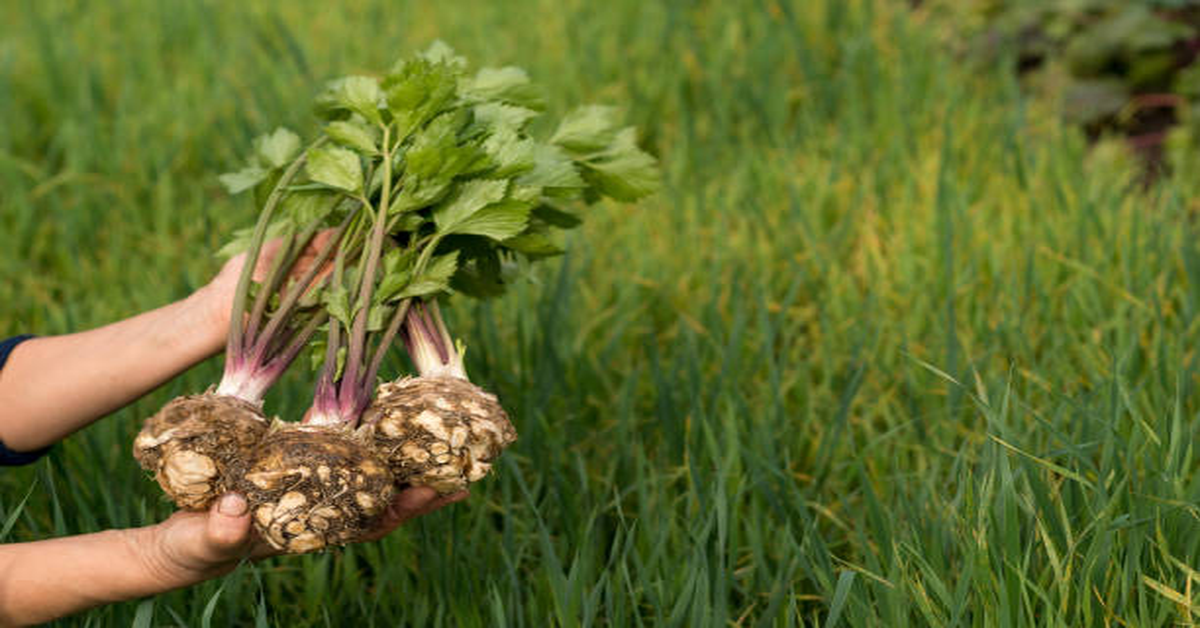
Pravi celer, known in English as true celery or Apium graveolens, is a well-recognized plant that has been valued both as a culinary ingredient and as a natural medicinal herb. It has a crisp texture, a refreshing aroma, and a wide array of nutrients that make it one of the healthiest vegetables available. For centuries, pravi celer has been cultivated and consumed across different parts of the world — from Mediterranean regions to Asia and Europe — as part of daily diets and traditional healing systems.
In this comprehensive article, we’ll explore the complete world of pravi celer — its botanical characteristics, nutritional value, historical significance, health benefits, traditional uses, cultivation methods, and modern applications in wellness and medicine. You’ll also learn how to include pravi celer in your meals in creative ways, and understand how its bioactive compounds support your overall well-being.
1. What is Pravi Celer?
Pravi celer (Apium graveolens) is a biennial plant belonging to the Apiaceae family, which also includes carrots, parsley, and fennel. It is commonly known simply as “celery” in most languages, but the term “pravi-celer” — literally meaning “true celery” — is often used in Eastern European regions to distinguish it from similar plants like lovage or celeriac.
The plant typically grows between 30 and 90 centimeters tall, featuring long, fibrous stalks with bright green leaves. Its unique aroma comes from volatile oils stored in the plant tissues, which are responsible for its distinct flavor and health-promoting properties. Both the stalks and leaves are edible, while the seeds and roots are often used for medicinal or seasoning purposes.
2. Botanical and Chemical Composition
The chemical composition of pravi celer reveals why it has earned such a reputation for healing. It contains a wide range of active compounds that work synergistically to improve body function and resistance to disease.
| Component | Nutritional / Biological Role |
|---|---|
| Vitamins (A, C, K, B-complex) | Support immune health, blood clotting, energy metabolism |
| Minerals (potassium, calcium, magnesium, iron) | Regulate blood pressure, bone strength, muscle function |
| Dietary Fiber | Promotes digestion and reduces cholesterol |
| Flavonoids (apigenin, luteolin) | Act as powerful antioxidants |
| Volatile oils (limonene, selinene) | Provide aroma and antimicrobial effects |
| Coumarins | Support circulation and act as mild anticoagulants |
| Polyphenols | Reduce inflammation and oxidative stress |
Each of these compounds contributes to pravi celer’s unique blend of nutrition and therapeutic potential. What makes it particularly interesting is that it provides all of these benefits while being extremely low in calories — making it ideal for modern health-conscious diets.
3. Historical Background and Cultural Significance
Pravi celer has a long history that dates back thousands of years. Ancient civilizations such as the Egyptians, Greeks, and Romans revered it not only as food but also as medicine. The Greeks used celery leaves to crown athletes and warriors, associating it with vitality and strength. The Romans used its seeds and extracts for treating indigestion and joint pain.
In traditional Chinese and Ayurvedic medicine, pravi celer was known as a cooling herb that helped reduce heat and inflammation in the body. It was often prescribed for hypertension, urinary issues, and as a natural detoxifier. Over time, its popularity spread throughout Europe, where it became a common ingredient in soups, salads, and broths.
Today, pravi celer is a staple vegetable in kitchens across the globe and a key ingredient in many health-based diets like the Mediterranean and DASH diet.
4. Nutritional Profile of Pravi Celer
Below is a table summarizing the nutritional value of 100 grams of raw pravi celer (approximate values):
| Nutrient | Amount per 100g |
|---|---|
| Calories | 16 kcal |
| Water | 95% |
| Protein | 0.7 g |
| Carbohydrates | 3 g |
| Fiber | 1.6 g |
| Fat | 0.2 g |
| Vitamin A | 22 µg |
| Vitamin C | 3 mg |
| Vitamin K | 29 µg |
| Potassium | 260 mg |
| Calcium | 40 mg |
| Magnesium | 11 mg |
| Sodium | 80 mg |
This composition shows that pravi celer is nutrient-dense despite its low caloric value. It provides hydration, electrolytes, vitamins, and minerals without adding fat or sugar — making it an excellent food for detoxification, hydration, and metabolic balance.
5. Health Benefits of Pravi Celer
The benefits of pravi celer extend far beyond simple nutrition. Regular consumption can support various physiological systems — cardiovascular, digestive, renal, and immune — through its natural phytochemicals. Let’s examine these in detail.
5.1 Supports Heart Health
Pravi celer is rich in potassium and phthalides, natural compounds known for their ability to relax arterial walls and improve blood circulation. This reduces high blood pressure, which is a key risk factor for heart disease. Furthermore, celery’s antioxidants reduce oxidative stress that can damage blood vessels.
5.2 Improves Digestion
The dietary fiber in pravi celer promotes healthy bowel movement and prevents constipation. It stimulates digestive enzymes and helps maintain a balanced gut microbiome. Its slightly bitter taste also encourages bile secretion, which aids fat digestion.
5.3 Detoxifies the Body
Because of its high water and antioxidant content, pravi celer helps flush out toxins from the liver and kidneys. It acts as a mild diuretic, increasing urine output and reducing water retention, which can help relieve bloating and swelling.
5.4 Reduces Inflammation
Flavonoids like apigenin and luteolin found in pravi celer are powerful anti-inflammatory agents. They inhibit enzymes responsible for inflammation, making celery beneficial for conditions such as arthritis, asthma, and chronic pain.
5.5 Supports Weight Loss
Low in calories but rich in fiber and water, pravi celer is ideal for weight management. It gives a sense of fullness, curbing overeating while providing essential micronutrients that prevent deficiencies during calorie restriction.
5.6 Enhances Skin and Hair Health
Vitamins A and C in pravi celer promote collagen production, improving skin elasticity and glow. The minerals support hair strength and scalp circulation, making it an excellent beauty food.
5.7 Helps Manage Blood Sugar
The fiber slows glucose absorption, preventing rapid spikes in blood sugar levels. This makes pravi celer beneficial for people with diabetes or those seeking to maintain stable energy levels throughout the day.
5.8 Boosts Immunity
Vitamin C and other antioxidants strengthen immune defense by stimulating white blood cell activity and protecting against infections.
6. Traditional and Medicinal Uses
Throughout history, pravi celer has been used in traditional medicine to treat various ailments. Here’s a look at how it was used in different systems of healing:
| Traditional System | Use / Application |
|---|---|
| Ayurvedic Medicine | Reduces Pitta (heat), cleanses liver, treats hypertension |
| Traditional Chinese Medicine (TCM) | Lowers blood pressure, cools internal heat, aids digestion |
| European Herbalism | Treats rheumatism, promotes urination, soothes nerves |
| Folk Remedies | Celery seed tea used for kidney stones, water retention, and stress relief |
These traditional applications align with modern scientific findings about pravi celer’s diuretic, anti-inflammatory, and antioxidant actions.
7. Pravi Celer Juice: A Popular Health Trend
In recent years, celery juice has gained immense popularity as a detoxifying drink. Advocates claim that drinking a glass of fresh pravi celer juice every morning can cleanse the liver, reduce inflammation, and enhance energy levels.
While not a miracle cure, scientific understanding supports many of these benefits. Fresh celery juice delivers concentrated nutrients and antioxidants in an easily absorbable form. It’s best consumed fresh on an empty stomach for maximum benefit.
How to Make Pravi Celer Juice:
- Wash 6–8 celery stalks thoroughly.
- Cut them into smaller pieces.
- Blend with half a cup of water until smooth.
- Strain and drink immediately without additives.
For enhanced taste, you can combine pravi celer juice with cucumber, lemon, or green apple.
8. How to Include Pravi Celer in Your Diet
Pravi celer is versatile and can be used in various culinary preparations:
| Form | Culinary Use |
|---|---|
| Raw | Salads, juices, snacks |
| Cooked | Soups, stews, sauces |
| Dried / Powdered | Spice or seasoning |
| Seeds | Herbal teas, flavoring |
| Leaves | Garnishes, green smoothies |
Here are some easy and healthy ideas:
- Add chopped celery to soups for extra texture.
- Mix celery leaves in smoothies for a chlorophyll boost.
- Use celery salt as a seasoning alternative for sodium reduction.
- Combine celery sticks with hummus for a nutritious snack.
9. Cultivation and Growing Conditions
Pravi celer is relatively easy to cultivate, provided it receives consistent moisture and mild temperatures.
| Requirement | Ideal Condition |
|---|---|
| Climate | Cool, temperate regions |
| Soil Type | Moist, well-drained loam rich in organic matter |
| pH Level | 6.0–7.0 |
| Sunlight | Full to partial sunlight |
| Watering | Frequent but moderate |
| Harvest Time | 90–120 days after planting |
Celery is commonly grown from seeds. They should be started indoors, as they germinate slowly, and later transplanted to the garden once seedlings are established. Regular watering is crucial because the plant is sensitive to drought.
Proper cultivation not only ensures good yield but also enhances the concentration of essential oils and flavor compounds in the plant.
10. Possible Side Effects and Precautions
Although pravi celer is generally safe, excessive intake or improper use can cause mild side effects in certain individuals.
| Possible Effect | Explanation / Risk Group |
|---|---|
| Allergic Reaction | Some people may react to celery pollen or oil. |
| Photosensitivity | High coumarin levels can make skin more sensitive to sunlight. |
| Pregnancy Risk | Celery seed extract in large doses may stimulate uterine contractions. |
| Drug Interaction | Diuretics or blood thinners may interact with celery compounds. |
To avoid complications, moderate consumption is recommended — especially for people with kidney disorders, blood pressure medications, or known allergies.
11. Comparison: Pravi Celer vs. Celeriac vs. Lovage
It’s common to confuse pravi celer with related plants, but they differ in structure and use.
| Feature | Pravi Celer | Celeriac (Root Celery) | Lovage |
|---|---|---|---|
| Part Used | Stalks and leaves | Bulbous root | Leaves and seeds |
| Flavor | Mild, fresh | Earthy, nutty | Strong, aromatic |
| Common Use | Salads, soups, juices | Purees, soups | Seasoning, herbal medicine |
| Nutritional Focus | Hydration and vitamins | Carbohydrates and minerals | Essential oils and aroma |
12. Scientific Research and Evidence
Modern research supports the traditional claims about pravi celer’s medicinal potential. Studies have shown that:
- Celery seed extract reduces blood pressure by promoting smooth muscle relaxation.
- Apigenin, a major compound in celery, has demonstrated anti-cancer and neuroprotective properties.
- Flavonoids and polyphenols in celery combat oxidative damage and inflammation in chronic diseases.
While more clinical trials are needed, evidence suggests that pravi celer is a valuable dietary addition for disease prevention and general wellness.
13. Storing and Preserving Pravi Celer
To maintain freshness and nutrient quality:
- Store celery stalks in a sealed container or wrapped in foil inside the refrigerator.
- Avoid washing before storage to prevent moisture spoilage.
- For longer shelf life, blanch and freeze chopped celery for soups or stews.
Celery seeds can also be dried and stored for seasoning or herbal tea.
14. Sustainable and Ecological Aspects
Pravi celer cultivation is environmentally friendly because it requires moderate resources and can be grown without heavy pesticide use. Additionally, every part of the plant — from leaves to seeds — can be utilized, minimizing waste. Sustainable farming practices such as composting and crop rotation further enhance soil health and biodiversity.
15. The Future of Pravi Celer in Nutrition and Medicine
With growing global interest in plant-based diets and natural health remedies, pravi celer is gaining renewed attention in both culinary and scientific communities. Its balance of hydration, fiber, and phytonutrients makes it a potential superfood for modern lifestyles. Researchers are exploring its applications in nutraceuticals, herbal supplements, and functional beverages.
Conclusion
Pravi celer stands as one of nature’s most versatile and healing plants. Beyond being a common vegetable, it’s a treasure trove of nutrients, antioxidants, and medicinal compounds that support nearly every system in the human body. From lowering blood pressure and improving digestion to enhancing skin and immunity, its benefits are vast and well-supported by both tradition and science.
Incorporating pravi celer into your diet — whether through salads, juices, or soups — is a simple yet powerful step toward better health. With its refreshing flavor and detoxifying properties, pravi celer truly embodies the phrase “food as medicine.”
FAQs
1. What is pravi celer good for?
Pravi celer supports heart health, improves digestion, reduces inflammation, aids detoxification, and helps in maintaining a healthy weight.
2. Can I drink pravi celer juice daily?
Yes, moderate consumption of fresh celery juice is safe and beneficial for hydration, liver function, and blood pressure control.
3. Is pravi celer good for diabetes?
Yes. Its fiber helps regulate blood sugar levels and slows glucose absorption, making it suitable for diabetic diets.
4. Can pravi celer help in weight loss?
Absolutely. It is low in calories and high in water and fiber, helping you feel full and reducing overeating.
5. How can I store pravi celer for longer freshness?
Keep celery stalks wrapped in aluminum foil or a sealed bag in the refrigerator. For long-term storage, blanch and freeze them.







